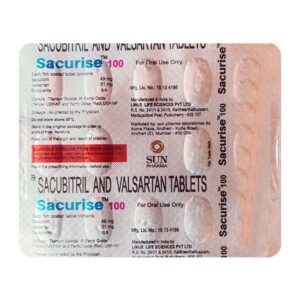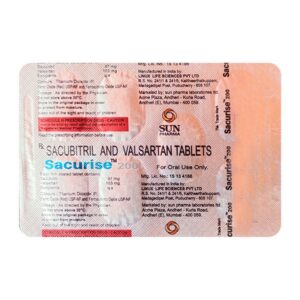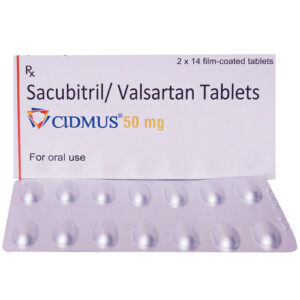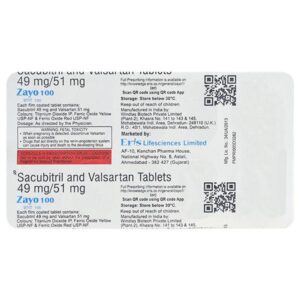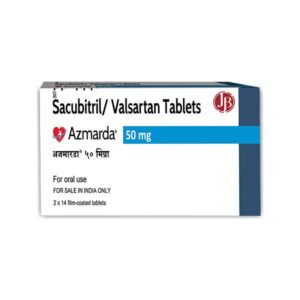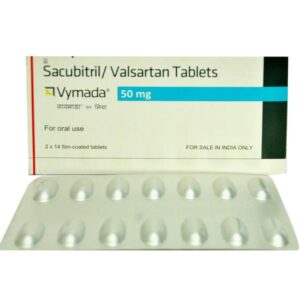VALSARTAN + SACUBITRIL
Valsartan: Valsartan is a medication primarily used to treat high blood pressure (hypertension) and heart failure. It belongs to a class of drugs called angiotensin II receptor blockers (ARBs).
The mechanism of action of Valsartan involves blocking the action of angiotensin II, a hormone that narrows blood vessels and increases blood pressure. By blocking the angiotensin II receptors, Valsartan helps to relax and widen blood vessels, thus reducing blood pressure and improving blood flow.
The typical starting dose of Valsartan for hypertension is 80 or 160 mg once daily, and the maximum recommended dose is 320 mg daily. For heart failure, the initial dose is usually 40 mg twice daily, with a target maintenance dose of 160 mg twice daily. The dosage may be adjusted based on individual response and tolerability.
Like any medication, Valsartan may have potential side effects. The most common side effects include dizziness, low blood pressure, headache, diarrhea, cough, tiredness, and back pain. In rare cases, it may cause more serious side effects such as angioedema (swelling of the face, lips, tongue, or throat), liver problems, kidney problems, or allergic reactions. If any severe side effects occur, it is important to seek medical attention immediately.
It’s worth noting that in recent years, Valsartan has been subject to recalls and warnings due to the presence of impurities (e.g. N-nitrosodimethylamine, NDMA) in certain batches from specific manufacturers. These impurities have the potential to increase the risk of cancer. If you are taking Valsartan, it is essential to consult with your healthcare provider and check if your medication is affected by any recalls or safety alerts.
Overall, Valsartan is an effective medication for managing high blood pressure and heart failure. However, it is important to follow the dosage guidelines, monitor for any potential side effects, and stay updated on any safety concerns related to specific manufacturers.
Sacubitril: Sacubitril is a medication used in the treatment of heart failure. It is specifically approved for use in patients with reduced ejection fraction, who are already on an ACE inhibitor or ARB.
The drug works by inhibiting the enzyme neprilysin, which is responsible for breaking down certain substances that can cause vasoconstriction and sodium retention. By inhibiting neprilysin, Sacubitril increases the levels of these substances, known as natriuretic peptides, which promote vasodilation, sodium excretion, and decreased blood pressure. This helps to reduce strain on the heart and improve heart failure symptoms.
Sacubitril is available in combination with Valsartan, another drug that works to block the effects of angiotensin II, a powerful vasoconstrictor, in a formulation called Sacubitril/Valsartan. This combination medication offers a dual mechanism of action to further reduce strain on the heart and improve cardiac function.
The recommended starting dose of Sacubitril/Valsartan is 49/51 mg twice daily. The dose can be increased to 97/103 mg twice daily after 2 to 4 weeks if tolerated. It is important to note that dosage adjustments may be necessary based on individual patient factors and the judgement of the healthcare provider.
As with any medication, Sacubitril can have side effects. The most common side effects include low blood pressure, dizziness, and an increased risk of angioedema. Angioedema is a serious allergic reaction that can cause swelling of the face, lips, tongue, and throat, leading to difficulty breathing. If angioedema occurs, immediate medical attention is necessary. Other potential side effects of Sacubitril/Valsartan may include hyperkalemia (high levels of potassium in the blood), impaired kidney function, and an increased risk of fetal harm if used during pregnancy.
It is important for patients to discuss any existing medical conditions or medications they are taking with their healthcare provider before starting Sacubitril/Valsartan to ensure its safe and effective use.


